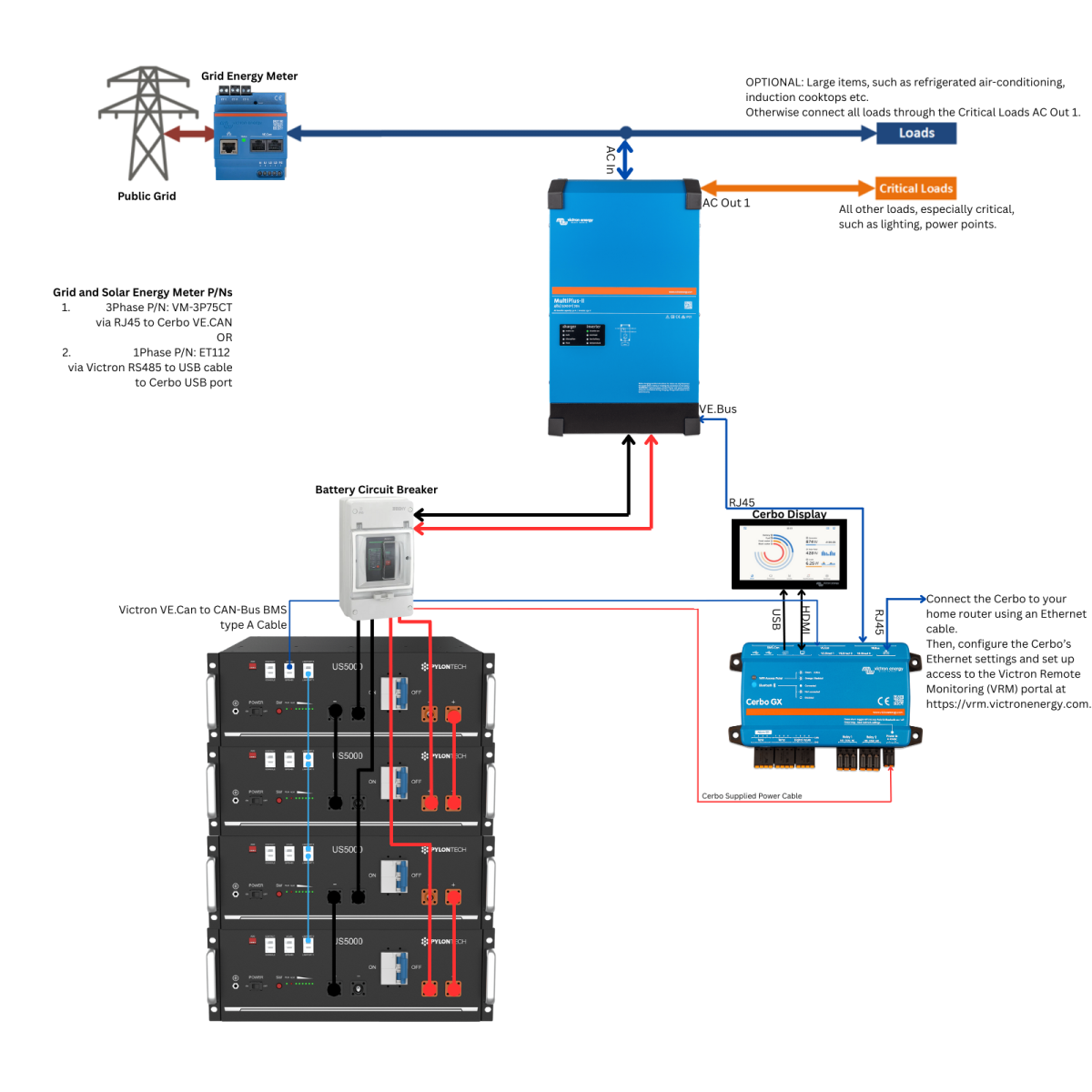Navigating the Complex Landscape of Energy Storage Systems: A Guide to Selecting Your Grid-Tie Victron ESS Scenario
An Energy Storage System (ESS) plays a key role in optimising energy use, especially when combined with solar PV. Selecting the right configuration is critical—whether your goal is to maximise solar self-consumption, maintain backup power during outages, or manage energy costs more effectively.
This document outlines eight on-grid ESS scenarios built around Victron Energy systems. It covers the logic behind each setup, their efficiency, metering requirements, and the pros and cons of each approach. Special attention is given to the impact of integrating third-party PV inverters.
The Building Blocks: Understanding Key Grid-Tie ESS Components & Concepts
A comprehensive understanding of the core components and operational principles is essential before delving into specific ESS scenarios. These elements work in concert, orchestrated by intelligent control systems, to deliver the desired energy management capabilities.
Core Components:
- Inverter/Charger (MultiPlus/Quattro): This is the cornerstone of a Victron ESS. Devices like the MultiPlus or Quattro are bidirectional, meaning they can charge the battery bank from AC sources (grid or generator) and invert DC power from the battery to supply AC loads. In an ESS, they manage the flow of energy between the grid, PV sources, batteries, and loads.
- Battery Bank: The energy reservoir of the system. The capacity and chemistry of the battery bank will dictate storage potential, discharge rates, and lifespan. Modern lithium-ion batteries often feature integrated Battery Management Systems (BMS) that can communicate with the Victron system for optimal performance.
- GX Device (e.g., Cerbo GX): This is the central communication hub and control unit for the ESS. A GX device, such as the Cerbo GX, is indispensable for any Victron ESS installation. It monitors all connected components, logs data, enables remote monitoring and control via the Victron Remote Management (VRM) portal, and runs the ESS control algorithms. Its role in coordinating energy flows, managing battery state of charge, and interfacing with various components cannot be overstated; without it, the sophisticated functionalities of an ESS are unattainable.
- PV Inverters (for AC-coupled PV): These devices convert DC power from solar panels into AC power. In AC-coupled systems, this AC power can be used directly by loads, fed to the grid, or used by the MultiPlus/Quattro to charge the batteries. Compatible Fronius inverters, for example, can communicate directly with the GX device for optimal AC coupling, as detailed in the Victron Energy documentation on AC Coupling with Fronius.
- MPPT Solar Chargers (for DC-coupled PV): Maximum Power Point Tracking (MPPT) solar chargers convert DC power from solar panels to the appropriate DC voltage for charging the battery bank directly. This is known as DC coupling.
- Energy Meters: These devices are crucial for measuring energy flows at various points in the system.
- Grid Meter: An external energy meter installed at the grid connection point is essential for full ESS functionality. It allows the system to measure power being imported from or exported to the grid, enabling features like self-consumption optimisation, zero feed-in, and accurate system monitoring.
- PV Inverter Meter: If an AC-coupled PV inverter cannot communicate its power production data directly to the GX device (e.g., it's not a compatible Fronius model or another supported brand with direct integration), a dedicated energy meter is required to measure its output. Compatible Fronius models, for example, can communicate directly, negating the need for an additional PV meter. For more details on integrating Fronius inverters, refer to Victron's guide on AC Coupling with Fronius. Non-communicating inverters will incur the cost and installation effort of this extra meter.
Key Concepts:
- AC Coupling vs. DC Coupling:
- AC Coupling: Solar energy is converted to AC by a PV inverter on the AC side of the system (either on the input or AC-out of the MultiPlus/Quattro). To charge batteries this AC power must be converted to DC by the MultiPlus/Quattro. This involves multiple conversion steps (PV DC to AC, then AC to battery DC) making it less efficient than DC Coupling.
- DC Coupling: Solar energy is fed directly to the battery bank via an MPPT solar charger on the DC side of the system. This is generally more efficient for charging batteries as it involves fewer power conversion stages (PV DC to battery DC).
- Grid-Tied (On-Grid): All scenarios discussed are on-grid, meaning the ESS is connected to and interacts with the public utility grid.
- Essential Loads vs. Non-Essential Loads: Many ESS installations differentiate loads. Essential (or critical) loads are those that must remain powered during a grid outage (e.g., refrigeration, medical equipment, basic lighting). These are typically connected to the AC-out of the MultiPlus/Quattro. Non-essential loads may be shed during an outage to conserve battery power.
- Feed-in: This refers to exporting surplus solar energy to the public grid. ESS can be configured to allow feed-in, limit it to a specific value, or prevent it entirely (zero feed-in). For certain PV inverters like Fronius, zero feed-in can be managed by the Victron GX device, controlling the PV inverter's output. Other systems might require specific configurations or hardware to achieve export limitation and is not recommended.
- The Factor 1.0 Rule: For AC-coupled PV inverters installed on the AC output of a Victron MultiPlus/Quattro, the total installed PV inverter power should not exceed the total Victron inverter/charger power (e.g., a 5 kVA unit should not have more than 5 kVA of PV inverter on its output). This is to ensure system stability, especially during off-grid operation.
- Black Start Capability: This is the ability of the system to restart and recharge batteries using solar power after a complete shutdown, such as a depleted battery during an extended grid outage, without needing the grid to be present. DC-coupled PV systems inherently offer excellent black start capabilities. AC-coupled PV systems typically require an active AC waveform (from the grid or the MultiPlus/Quattro) to start, making black start more complex or impossible without a DC PV component.
Unpacking the Scenarios: A Detailed Look at Your Options
The following eight scenarios represent common on-grid ESS configurations. Each has unique characteristics influencing its suitability for different applications. The necessity of a Cerbo GX (or equivalent GX device) is universal across all these ESS setups for intelligent system operation. A grid meter is also considered standard for full ESS functionality, enabling precise control over grid interaction.
Scenario 1: On Grid with AC Grid PV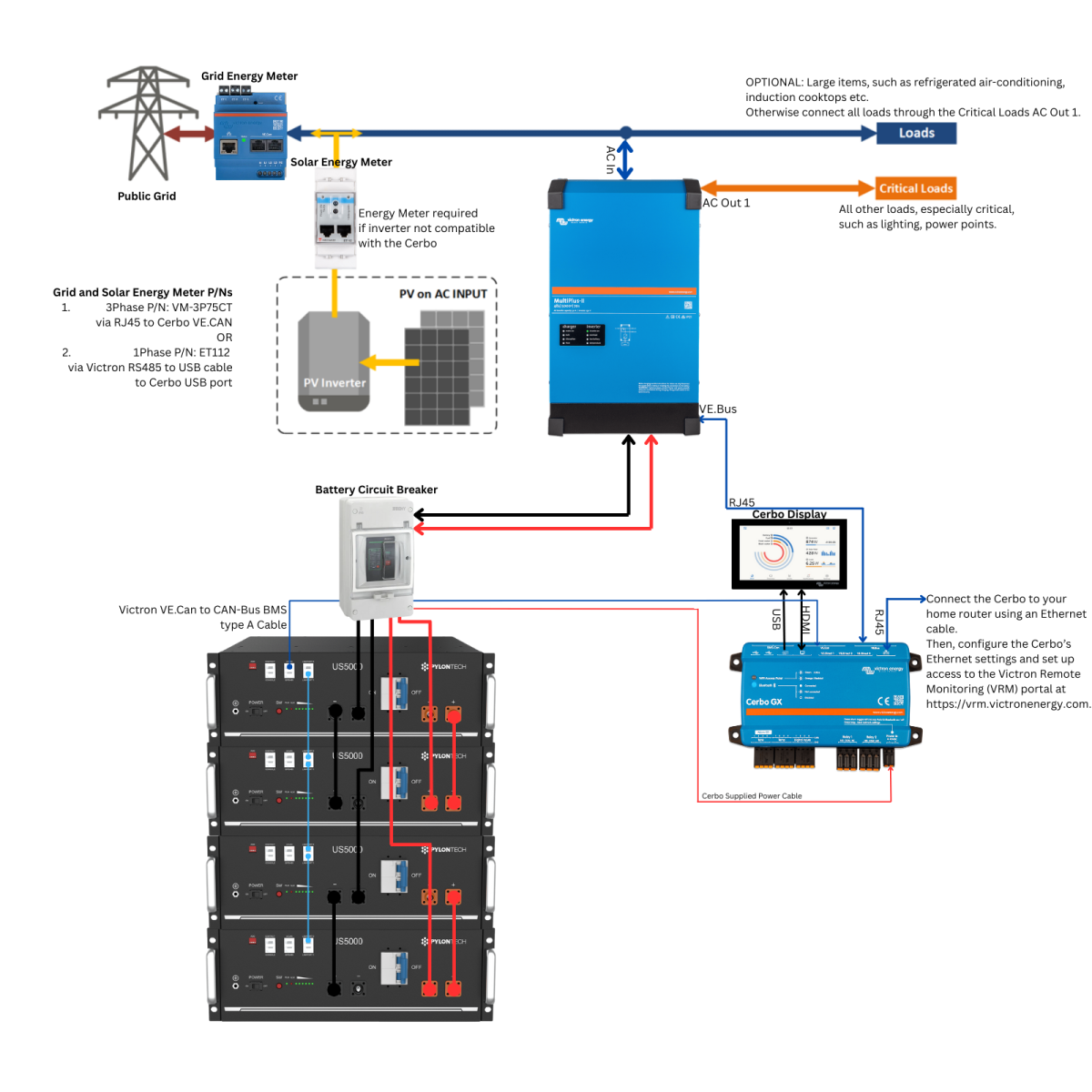
- Description: An AC-coupled PV inverter is installed on the AC input (grid side) of the Victron MultiPlus/Quattro.
- Use Case: Primarily for retrofitting an ESS to an existing grid-tied solar PV installation. It allows the existing PV system to continue operating as before, with the ESS now able to store surplus solar energy or grid power.
- Efficiency: For storing solar energy in the battery, the pathway is PV (DC) → PV Inverter (AC) → MultiPlus/Quattro Charger (DC). For using stored energy, it's Battery (DC) → MultiPlus/Quattro Inverter (AC) → Loads. These multiple conversion stages lead to moderate overall efficiency.
- Metering:
- Grid Meter: 1x External (e.g., ET112, VM-3P75CT).
- PV Meter: 1x External energy meter is required for the AC PV inverter if it does not natively communicate its production data to the Cerbo GX. Compatible Fronius inverters, for example, can communicate directly, negating the need for an additional PV meter. Non-communicating inverters will incur the cost and installation effort of this extra meter.
- Advantages: Easiest way to add battery storage to existing AC-coupled PV systems. Minimal disruption to the existing PV installation.
- Disadvantages: Lower PV-to-battery charging efficiency compared to DC coupling. During a grid outage, the AC Grid PV inverter (located on the AC input/grid side) will shut down as it loses its grid reference and for anti-islanding safety. In typical household ESS configurations for this scenario, the MultiPlus/Quattro powers essential loads on its AC output but does not re-energize the AC input; therefore, the AC Grid PV cannot contribute to powering loads or charging batteries during the outage. No black start capability from the AC PV alone.
Scenario 2: On Grid with AC Essential Load PV
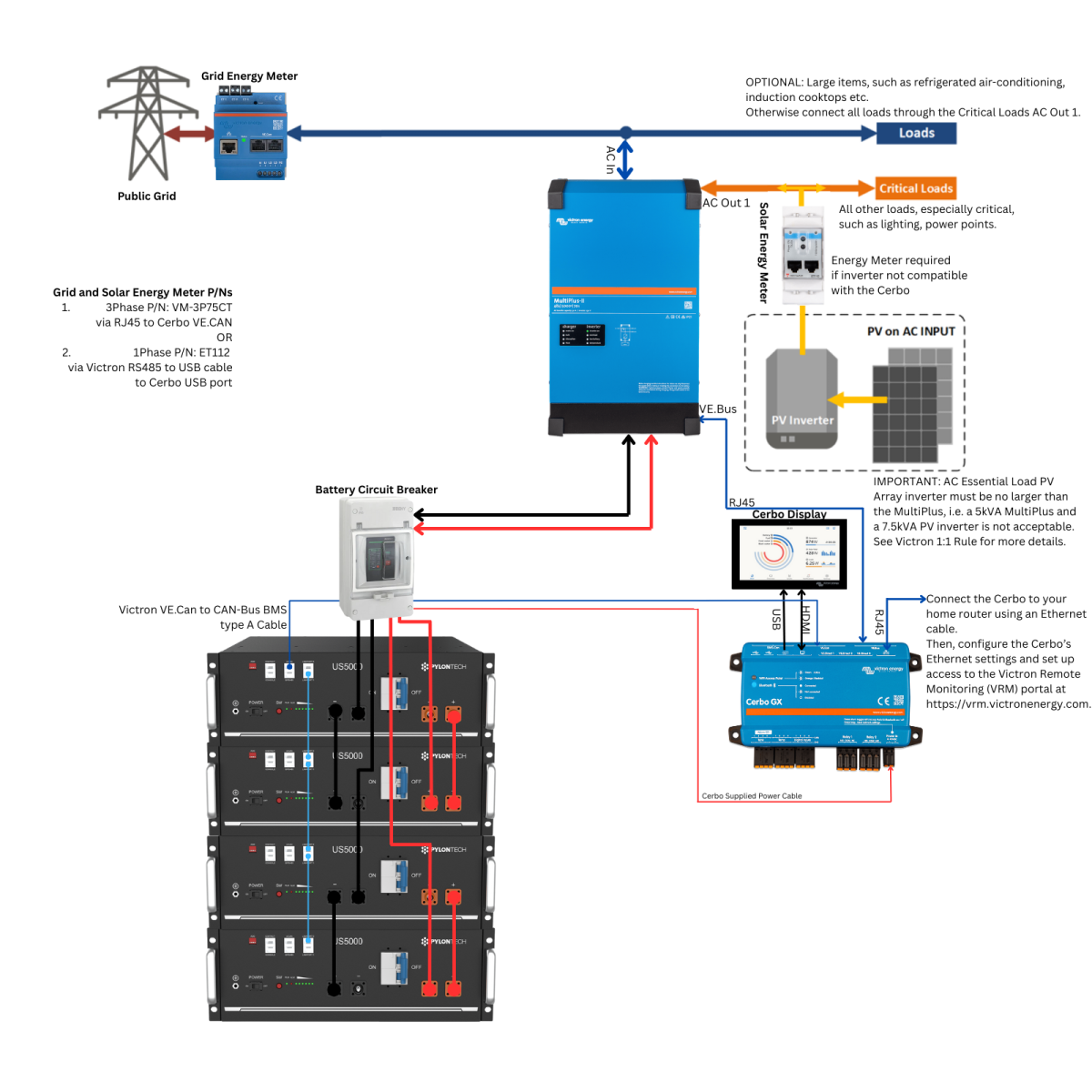
- Description: An AC-coupled PV inverter is installed on the AC output (critical load side) of the Victron MultiPlus/Quattro.
- Use Case: To provide solar power directly to essential loads and charge batteries, especially during grid outages. This setup ensures that if the grid fails, the PV on AC-out can continue to operate (as long as the MultiPlus/Quattro is forming the AC output) and support the critical loads and charge the battery.
- Efficiency: PV (DC) → PV Inverter (AC) → Loads (AC) / MultiPlus/Quattro Charger (DC). Efficiency is generally good for direct consumption by essential loads.
- Metering:
- Grid Meter: 1x External.
- PV Meter: Often not required if the AC PV inverter communicates directly with the Cerbo GX (e.g., compatible Fronius models). For non-communicating inverters, an external meter is required.
- Advantages: Provides solar power to essential loads even during grid outages (if battery has charge or sun is shining). Can be more efficient for direct self-consumption on critical load circuits.
- Disadvantages: The AC Essential Load PV inverter only operates when the MultiPlus/Quattro is active and providing an AC waveform on its output. The Factor 1.0 rule strictly applies: the PV inverter's rated power must not exceed the MultiPlus/Quattro's rated power. This can limit the size of the PV array on the AC output. Not black start capable.
Scenario 3: On Grid with DC PV Direct to Battery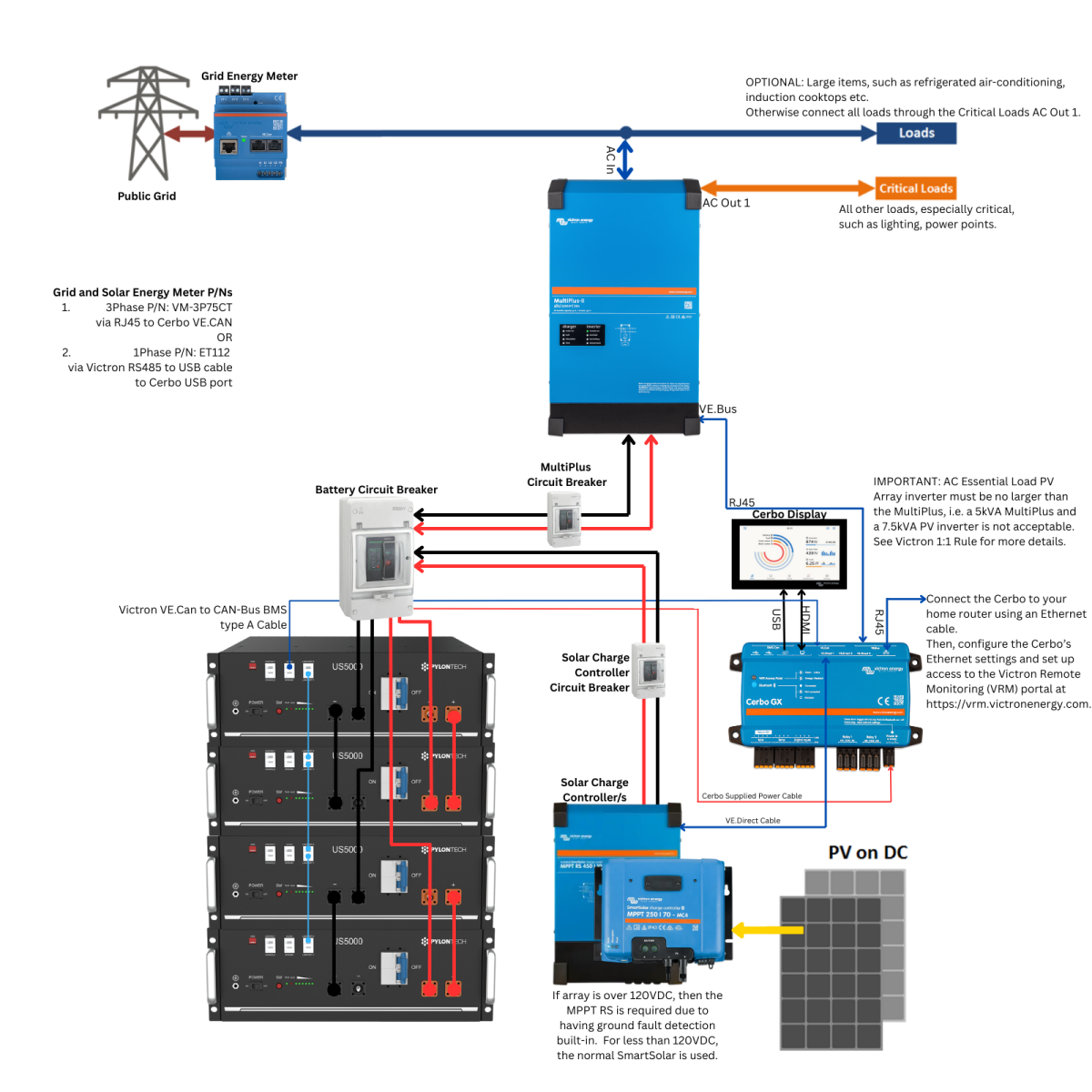
- Description: Solar panels are connected to MPPT solar chargers, which then charge the battery bank directly. All loads are supplied by the MultiPlus/Quattro from the battery or grid.
- Use Case: Ideal for new installations where maximising battery charging efficiency and achieving robust black start capability are priorities.
- Efficiency: Highest PV-to-battery charging efficiency due to direct DC-DC conversion.
- Metering:
- Grid Meter: 1x External.
- PV Meter: Not required. MPPT solar chargers communicate their production data directly to the Cerbo GX via VE.Direct or VE.Can.
- Advantages: Most efficient method for charging batteries from solar. Excellent black start capability – the system can recover from a depleted battery using solar power alone. Simpler setup compared to AC-coupled systems with frequency shifting requirements with best reliability.
- Disadvantages: May not be as suitable for very large PV arrays if the array needs to be located far from the battery bank, as DC cabling for high currents over long distances can be costly and less efficient than AC transmission.
Scenario 4: On Grid with AC Grid PV + DC PV Direct to Battery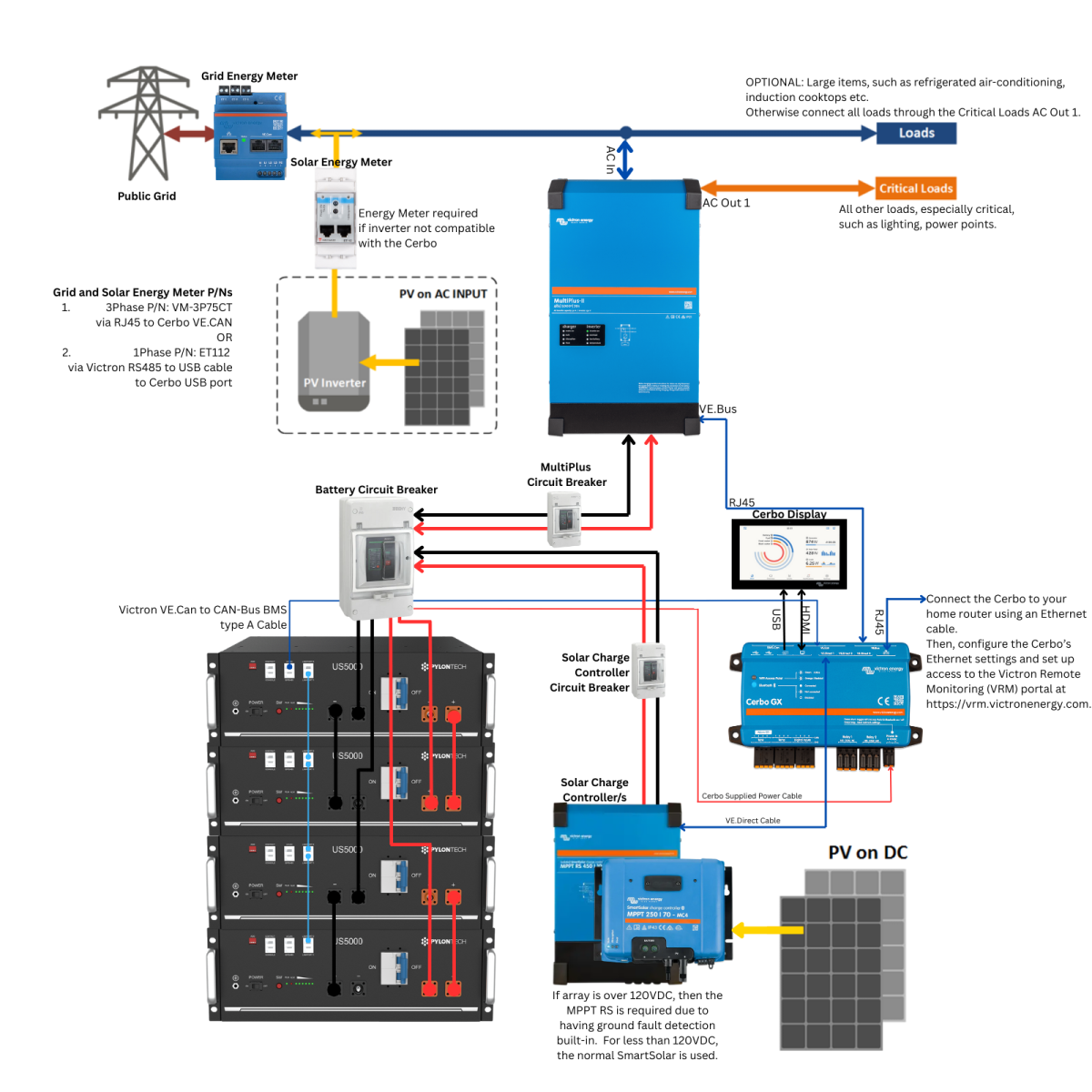
- Description: Combines Scenario 1 and Scenario 3. Features both an AC-coupled PV inverter on the grid side and DC-coupled PV via MPPT chargers.
- Use Case: To maximise solar harvest from different roof orientations or types of solar arrays (e.g., an existing AC-coupled array and a new DC-coupled one). Offers redundancy in solar charging.
- Efficiency: Mixed. The DC-coupled portion offers high battery charging efficiency, while the AC-coupled portion has moderate efficiency for battery charging.
- Metering:
- Grid Meter: 1x External.
- PV Meter: 1x External for the AC Grid PV inverter if it's non-communicating. No meter for DC PV.
- Advantages: Utilises diverse solar inputs. Black start capability from the DC-coupled PV. Increased overall solar generation potential.
- Disadvantages: Increased system complexity and cost due to multiple types of PV integration. Requires more careful setting configuration.
Scenario 5: On Grid with AC Grid PV + AC Essential Load PV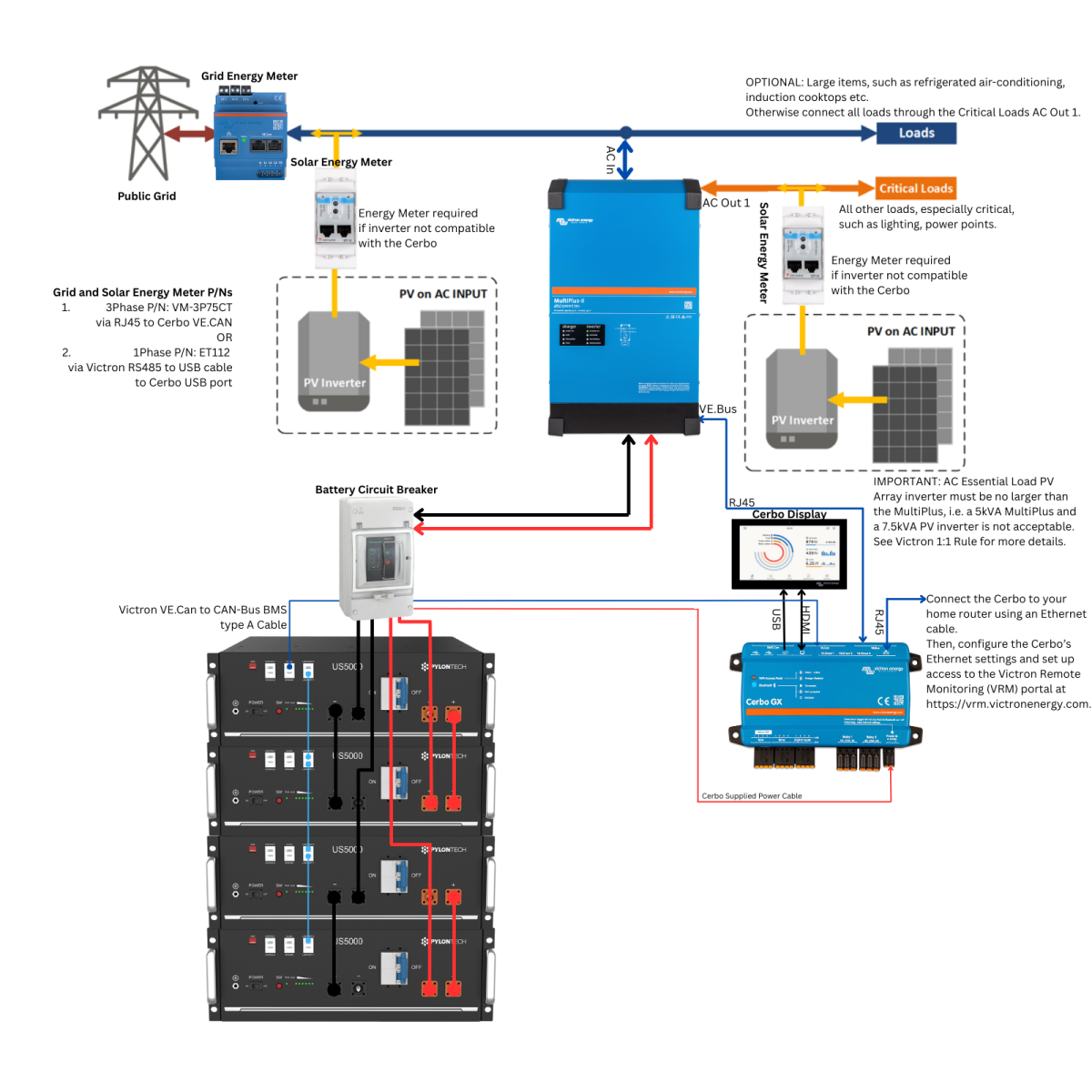
- Description: Combines Scenario 1 and Scenario 2. Features an AC-coupled PV inverter on the grid side and another AC-coupled PV inverter on the essential load (AC output) side.
- Use Case: For systems with existing grid-tied PV who wish to add dedicated solar support for critical loads during outages, or to maximise self-consumption across different load panels.
- Efficiency: Moderate, with multiple AC-DC-AC conversions depending on energy flow.
- Metering:
- Grid Meter: 1x External.
- PV Meter: 1x External for the AC Grid PV (if non-communicating). The AC Essential Load PV meter is not required if the AC PV inverter communicates directly with the Cerbo GX (e.g., compatible Fronius models). For non-communicating inverters, an external meter is required.
- Advantages: Supports general self-consumption/feed-in via AC Grid PV and dedicated backup for essential loads via AC Essential Load PV.
- Disadvantages: High complexity. Both AC PV systems are subject to their respective operational conditions (AC Grid PV typically off during outage, AC Essential Load PV needs MultiPlus active and adheres to Factor 1.0 rule). Potential for significant metering costs if both AC PV inverters are non-communicating.
Scenario 6: On Grid with AC Essential Load PV + DC PV Direct to Battery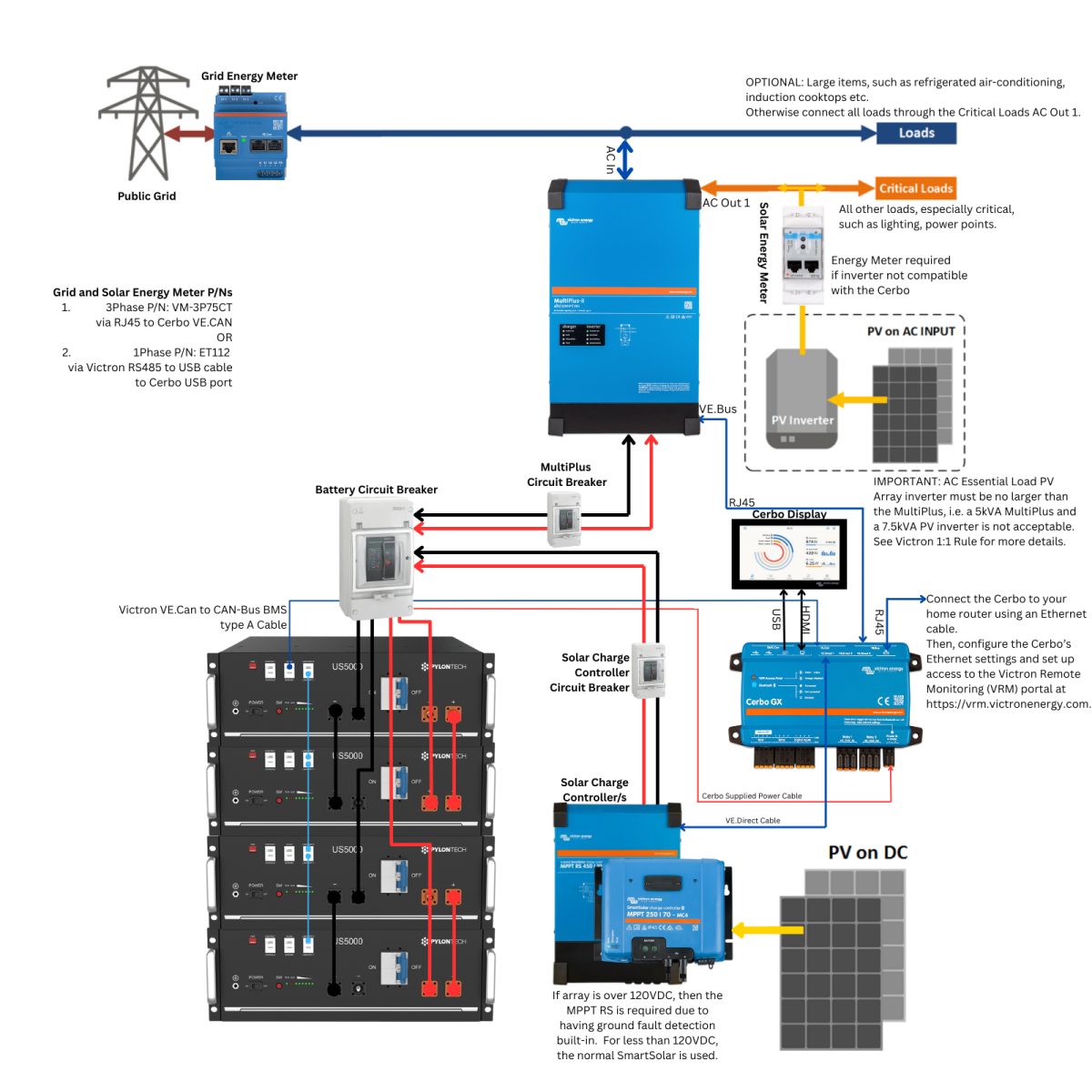
- Description: Combines Scenario 2 and Scenario 3. Features an AC-coupled PV inverter on the essential load side and DC-coupled PV via MPPT chargers.
- Use Case: A robust solution offering efficient DC charging, black start, and dedicated solar support for essential loads during outages.
- Efficiency: Mixed. High efficiency from DC PV to battery; moderate from AC Essential Load PV.
- Metering:
- Grid Meter: 1x External.
- PV Meter: Potentially 1x External for AC Essential Load PV if non-communicating/detailed separate monitoring is desired. No meter for DC PV.
- Advantages: Black start capability from DC PV. Efficient battery charging from DC PV. Solar support for essential loads during outages from AC Essential Load PV.
- Disadvantages: Increased complexity and cost compared to single-source PV systems. The Factor 1.0 rule applies to the AC Essential Load PV.
Scenario 7: On Grid with AC Grid PV + AC Essential Load PV + DC PV direct to battery.png)
- Description: The most comprehensive configuration, combining Scenarios 1, 2, and 3. Features AC-coupled PV on the grid side, AC-coupled PV on the essential load side, and DC-coupled PV.
- Use Case: For maximum solar energy harvesting from multiple. Suitable for complex installations with varied solar resources and critical backup needs.
- Efficiency: Mixed, with the DC-coupled component offering the highest battery charging efficiency.
- Metering:
- Grid Meter: 1x External.
- PV Meter: Potentially 2x External meters – one for the AC Grid PV and one for the AC Essential Load PV, if both are non-communicating types. This significantly adds to the cost and complexity of metering.
- Advantages: Highest potential for solar energy utilisation. Black start capability from DC PV. Multiple layers of solar input for redundancy and maximising generation under various conditions.
- Disadvantages: Highest system complexity, installation effort, and cost. Metering can become extensive and expensive if using non-communicating AC PV inverters. Requires expert design and commissioning. The sheer number of components and interactions demands careful management.
Scenario 8: On Grid with no Solar
- Description: The system functions mostly as an Uninterruptible Power Supply (UPS), charging batteries from the grid and providing backup power to loads during an outage. No PV integration. Furthermore, with appropriate configuration, this system can also actively interact with the grid when it is operational, including the option to feed stored battery energy back to the grid.
- Use Case: To provide backup power for essential loads in locations without solar PV, or where the primary goal is simply to bridge power interruptions. With a Cerbo GX and ESS assistant, it can offer intelligent battery management.
- Efficiency: Grid (AC) → MultiPlus/Quattro Charger (DC) → Battery. Battery (DC) → MultiPlus/Quattro Inverter (AC) → Loads. Standard conversion losses apply.
- Metering:
- Grid Meter: 1x External.
- Advantages: Simplest and potentially lowest initial cost for a backup power system if solar is not a factor. Can be configured for intelligent battery management (e.g., scheduled charging from the grid at specific State of Charge (SoC) levels) when using the ESS assistant with a Cerbo GX, elevating it beyond a simple UPS.
- Disadvantages: No solar self-consumption or renewable energy benefits. Solely reliant on the grid for battery charging. Limited runtime during outages, dictated by battery capacity.
Head-to-Head: Comparing Your ESS Options
To facilitate a clearer comparison, the table below summarises key aspects of the eight ESS scenarios. Note that "PV Meter(s) Needed" assumes the use of non-communicating AC PV inverters; if compatible, communicating PV inverters (e.g., certain Fronius models) are used, the need for dedicated AC PV meters may be eliminated. The Cerbo GX is considered essential for all true ESS functionalities.
| Scenario # & Name | Typical Use Case / Rationale | Relative PV-to-Battery Efficiency | Black Start Capability | Retrofit Friendliness | PV Meter(s) Needed (Typical, for non-comm. AC PV) | Key Advantages | Key Disadvantages | Relative Complexity/Cost Indication |
|---|---|---|---|---|---|---|---|---|
| 1. On Grid with AC Grid PV | Retrofit existing grid-tied solar | Medium | No (from AC PV alone) | High | 1 (1 per non-comm. AC PV inverter) | Easy retrofit; utilises existing PV. | Lower PV-to-battery efficiency; AC PV typically off during grid outage; no black start from AC PV. | Medium |
| 2. On Grid with AC Essential Load PV | Backup for essential loads with solar during outages; self-consumption on critical circuits. | Medium | No (from AC PV alone, but supports loads if Multi active) | Medium | 1 (1 per non-comm. AC PV inverter) | Solar for essential loads during outage. | AC PV only works when Multi is active; Factor 1.0 rule limits PV size. | High |
| 3. On Grid with DC PV direct to battery | New install; max battery charging efficiency & black start. | Highest | Yes (from DC PV) | Low (for existing AC PV systems, new install ideal) | 0 (MPPTs report directly) | Highest PV-to-battery efficiency; black start capable; simpler setup. | Can be less ideal for very large/distant arrays; battery worked harder. | Medium |
| 4. On Grid with AC Grid PV + DC PV direct to battery | Maximise solar from diverse arrays; add DC PV to existing AC PV. | Mixed (High for DC, Med for AC) | Yes (from DC PV) | Medium | 1 (1 per non-comm. AC PV inverter) | Utilises diverse solar; black start from DC PV; increased solar yield. | Increased complexity & cost. | High |
| 5. On Grid with AC Grid PV + AC Essential Load PV | Retrofit AC Grid PV & add dedicated AC PV for essential backup. | Medium | No (from AC PV alone) | Medium | 2 (1 per non-comm. AC PV inverter) | Supports general self-consumption & dedicated essential load backup from separate AC PV. | High complexity; Factor 1.0 rule for AC Ess. PV inverter; both AC PV types have limitations during outages. Metering costs can increase. | Very High |
| 6. On Grid with AC Essential Load PV + DC PV direct to battery | Robust backup with diverse solar charging for essential loads. | Mixed (High for DC, Med for AC) | Yes (from DC PV) | Medium | 1 (1 per non-comm. AC PV inverter) | Black start from DC PV; efficient DC charging; dedicated AC PV for essential loads. | Increased complexity & cost; Factor 1.0 rule for AC Ess. PV inverter. | Very High |
| 7. On Grid with AC Grid PV + AC Essential Load PV + DC PV direct to battery | Ultimate flexibility & resilience; max solar from all sources. | Mixed (High for DC, Med for ACs) | Yes (from DC PV) | Low/Complex | 2 (1 per non-comm. AC PV inverter) | Highest solar utilisation; black start from DC PV; multiple solar support layers. | Very high complexity & cost; significant installation effort; extensive metering if non-comm. AC PVs used. | Extremely High |
| 8. On Grid with no solar | Pure backup; potential smart grid charging. | N/A (Grid to Battery is AC-DC) | No | N/A | 0 | Simplest backup setup; lower initial cost if no PV; smart battery management possible. | No solar benefits; relies on grid for charging; limited runtime. | Low |
Important Note on Grid Feed-In Capability (For Australian Installations)
A critical factor when designing an ESS, particularly if you intend to export energy back to the grid from sources managed by the MultiPlus/Quattro (i.e., not from AC Grid PV directly connected on the grid side of the MultiPlus/Quattro), is the selection of the inverter/charger itself. This is especially pertinent for Australian installations requiring Clean Energy Council (CEC) approval for grid-interactive inverters.
If your system includes:
- An AC-coupled PV inverter on the AC output (essential load side) of the MultiPlus/Quattro (as in Scenarios 2, 5, 6, 7), or
- DC-coupled PV charging the batteries via MPPT solar chargers (as in Scenarios 3, 4, 6, 7), or
- You are operating in a UPS-only mode (Scenario 8) and wish to export stored battery energy to the grid (e.g., for grid services or tariff optimisation),
and you intend for any of this generated or stored energy to be fed back into the public utility grid, it is typically mandatory to use a Victron inverter/charger model that is specifically approved for grid connection and feed-in by relevant authorities in your region. For Australian installations, this generally means using a model compliant with AS/NZS 4777.2 and included on the CEC list of approved grid-connect inverters, such as the MultiPlus-II 48/5000 (specific SKUs/models are listed by the CEC for such approval).
It's important to note that Victron MultiPlus inverter/chargers are typically set up from the factory to *not* export energy to the grid. To enable grid export functionality, you will need to change this setting, which often requires entering a specific grid code password. For Australian installations, this password is TPWMBU2A4GCC. The standard MultiPlus settings password is zzz.
If a non-grid-interactive model, or a model not specifically CEC-approved for grid feed-in (for Australian sites), is used in these capacities, or if the system is not configured and approved for export by your utility and electrical inspector:
- Energy from an AC essential load PV inverter can only be used to power essential loads connected to the MultiPlus/Quattro's output and for battery charging.
- Energy from DC-coupled PV can only be used for battery charging and for self-consumption by loads powered via the MultiPlus/Quattro (either directly from PV when available or from the battery).
- In UPS-only mode, or with any battery-stored energy (regardless of its original source – solar or grid), this energy can only be used to power your loads connected to the MultiPlus/Quattro.
In such cases, no feed-in (export) to the grid from these energy sources via the MultiPlus/Quattro will be permissible. The system's interaction with the grid, for energy pathways managed by that inverter/charger, would be limited to importing power or ensuring zero export from these sources. The PV energy, in this context, can then only be used for charging the system's batteries and supplying power to your on-site essential loads.
Specific electricity distributors may require additional specific rules, please check with your Victron installer to ensure full compliance with Australian standards and network connection requirements.
VPP Readiness and Upcoming Battery Rebates (2025)
Certain Victron inverters with a GX device, such as the MultiPlus-II 48/5000, are Virtual Power Plant (VPP) ready, making them compatible with both state and federal programs aimed at encouraging smart, grid-interactive energy systems. This VPP readiness ensures:
- They can integrate with energy retailers and aggregators for grid services such as demand response and load shifting.
- They are eligible for participation in state-based VPP programs and trials.
- They may qualify for new battery rebates announced by the Labor Government for 2025.
These rebates and initiatives are detailed in:
When paired with an approved, compatible battery such as the Pylontech 5000-B, a Victron-based system not only offers reliable backup and off-grid capabilities, but also provides a future-ready platform for energy market participation and may provide access to government incentives.
Tip: Always check whether your chosen battery model appears on the official VPP Ready Battery List, and ensure your installer follows all requirements for rebate eligibility and VPP integration.
Charting Your Course: Selecting the Perfect ESS Scenario
The "perfect" ESS scenario is not a one-size-fits-all solution; it is deeply intertwined with individual energy objectives, existing infrastructure, budget, and tolerance for complexity. A careful self-assessment is crucial. Consider the following questions to guide your decision-making process:
- What are your primary objectives? Are you aiming to maximise self-consumption of your solar energy, ensure uninterrupted power for critical loads during outages, reduce your electricity bills through tariff arbitrage, achieve a degree of grid independence, or simply implement a reliable UPS function? Clearly defining these priorities will heavily influence your choice.
- Do you have an existing solar PV system?
- If yes: Is it an AC grid-tied system? What is its brand and model – specifically, can it communicate its production data to a Victron GX device (e.g., is it a compatible Fronius inverter )? What is its size? Or is it a DC-based system? The nature of an existing system is a primary determinant; retrofitting an AC-coupled PV system (Scenario 1) is common but necessitates checking compatibility or budgeting for an additional PV meter.
- If no: Are you planning a new PV installation alongside the ESS? This offers greater flexibility in choosing an optimal configuration, such as a highly efficient DC-coupled system (Scenario 3).
- What is your budget for the ESS? This includes the inverter/charger, batteries, GX device, installation, and crucially, any additional energy meters required for non-communicating PV inverters. The cost and effort associated with these meters should not be underestimated.
- What are your critical loads that need backup during a power outage? Identifying these loads and their power requirements will help determine the necessary size of the MultiPlus/Quattro and the battery bank.
- What is the typical duration and frequency of power outages in your area? Longer or more frequent outages may justify a larger battery bank and more robust solar charging capabilities, potentially favouring scenarios with DC PV for black start and efficient recharging (e.g., Scenarios 3, 4, 6, 7).
- Are there any local regulations regarding grid feed-in? Some jurisdictions require zero feed-in, while others allow limited or full feed-in. Victron ESS can manage feed-in, especially effectively with communicating PV inverters like Fronius. Non-communicating inverters might make precise feed-in control more complex or reliant on additional external controls. Systems can be configured to limit export.
- How important is "black start" capability to you? If being able to restart your system using only solar power after a prolonged outage and battery depletion is critical, scenarios incorporating DC-coupled PV (3, 4, 6, 7) are highly advantageous.
- What is your tolerance for system complexity versus your desire for maximum features and resilience? More sophisticated scenarios (like 4, 5, 6, and especially 7) offer greater capabilities but come with increased complexity in design, installation, and potentially troubleshooting.
Brief Recommendations Based on Common Priorities:
- Existing Grid-Tie PV System (Retrofit): Scenario 1 (On Grid with AC Grid PV) is often the most straightforward. Diligently check if your PV inverter is compatible for direct data communication with Victron GX devices to avoid the need for an extra PV meter. If not, factor in the cost of an additional meter.
- New System, Prioritising Battery Charging Efficiency & Black Start: Scenario 3 (On Grid with DC PV direct to battery) is generally the optimal choice for its high efficiency and inherent black start capability.
- Basic UPS Functionality, No Solar: Scenario 8 (On grid with no solar, UPS only) provides reliable backup. Utilising a Cerbo GX and the ESS assistant can add smart features like scheduled grid charging.
- Complex Needs, Multiple PV Arrays, Maximum Resilience: Scenario 6 offers the most comprehensive solution by integrating various PV types. However, be prepared for significantly higher costs, complexity, and the potential need for a PV energy meter if using a non-communicating AC PV inverter.
- Strict Zero Feed-in Requirement with AC-Coupled PV: Strongly consider using Fronius PV inverters or other brands that are known to communicate effectively with Victron GX devices for feed-in control. More information can be found in the Victron Energy documentation on AC Coupling with Fronius. This simplifies the implementation of zero feed-in and can obviate the need for additional PV energy meters purely for monitoring that PV source.
Australian Standards and High‑Voltage Solar Installations
In Australia, solar PV and battery installations must adhere to strict standards. Key among these are AS/NZS 5033:2021 (which covers installation and safety requirements for PV arrays, including d.c. wiring, protection devices and earthing), AS/NZS 5139:2019 (covering the safe installation of battery energy storage systems), and AS/NZS 4777.2:2020 (outlining inverter requirements for grid connection of energy systems). For higher-voltage solar setups, using a compliant charge controller such as Victron’s SmartSolar RS series (e.g. the 48 V 100 A SmartSolar RS and the 48 V 200 A SmartSolar RS) is preferred over standard SmartSolar units because it provides galvanic isolation and includes a built-in ground-fault detection/interruption (GFDI) system. Notably, AS/NZS 5033 defines 120 V DC (nominal) as the upper limit for extra-low voltage, below which earth-fault protection isn’t required. Once you exceed that threshold (common in permanent installations or grid-connected systems), an earth-fault alarm or protection device becomes mandatory to quickly detect any insulation failures or ground leakage. The SmartSolar RS addresses this by continuously monitoring array isolation and automatically detecting ground faults, helping installers meet these safety requirements. By choosing equipment with such features – and ensuring all components are compliant with AS/NZS 5033, 5139, and 4777.2 – installers can emphasise safety and guarantee that the system meets Australia’s stringent compliance standards.
Powering Forward with Confidence
The selection of an Energy Storage System scenario is a critical decision that will shape your energy independence, resilience, and economic benefits for years to come. Each of the eight scenarios presented offers a unique balance of features, efficiencies, and complexities. By carefully considering your specific needs, existing infrastructure, and budget, and by understanding the implications of component choices—particularly regarding energy metering for PV inverters—it is possible to identify the configuration that best aligns with your objectives.
Use this guide as a reference during system design and quoting.
- Confirm PV inverter compatibility for feed-in and metering simplicity
- Match system goals to the most efficient and resilient ESS layout
- Ensure compliance with AS/NZS standards and CEC-approved hardware
- Future-proof your installs with GX devices and black start-capable configurations
- Always ensure all system firmware is updated to the latest version for optimal performance and compatibility.
Need support, clarification, or a second opinion on a complex setup?
Reach out to us – we're here to help ensure every install is robust, standards-compliant, and VPP-ready.
Contact Us for More Information, Stock Availability and Pricing





























